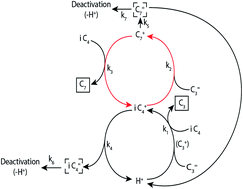当前位置:
X-MOL 学术
›
Faraday Discuss.
›
论文详情
Our official English website, www.x-mol.net, welcomes your
feedback! (Note: you will need to create a separate account there.)
The challenge of catalyst prediction
Faraday Discussions ( IF 3.3 ) Pub Date : 2018-01-15 , DOI: 10.1039/c7fd00208d Rutger A. van Santen 1, 2, 3, 4, 5 , Aditya Sengar 2, 3, 4, 6, 7 , Erik Steur 4, 8, 9
Faraday Discussions ( IF 3.3 ) Pub Date : 2018-01-15 , DOI: 10.1039/c7fd00208d Rutger A. van Santen 1, 2, 3, 4, 5 , Aditya Sengar 2, 3, 4, 6, 7 , Erik Steur 4, 8, 9
Affiliation

|
New insights and successful use of computational catalysis are highlighted. This is within the context of remaining issues that prevent theoretical catalysis to be fully predictive of catalyst performance. A major challenge is to include in modelling studies the transient initiation as well as deactivation processes of the catalyst. We will illustrate this using as an example for solid acid catalysis, the alkylation process, and for transition metal catalysis, the Fischer–Tropsch reaction. For the alkylation reaction of isobutane and alkene, an important reaction for high octane gasoline, we will present a deactivation model. For the Fischer–Tropsch reaction, which converts synthesis gas into gasoline grade molecules, we discuss structural reorganization of the catalyst induced by reaction.
中文翻译:

催化剂预测的挑战
强调了新的见解和成功使用计算催化。这是在剩余的问题的背景下进行的,这些问题阻止理论催化完全预测催化剂的性能。一个主要的挑战是在模型研究中包括催化剂的瞬态引发和失活过程。我们将以固体酸催化(烷基化过程)和过渡金属催化(费-托反应)为例进行说明。对于异丁烷和烯烃的烷基化反应,这是高辛烷值汽油的重要反应,我们将提出一种失活模型。对于将合成气转化为汽油级分子的费托反应,我们讨论了反应引起的催化剂的结构重组。
更新日期:2018-09-03
中文翻译:

催化剂预测的挑战
强调了新的见解和成功使用计算催化。这是在剩余的问题的背景下进行的,这些问题阻止理论催化完全预测催化剂的性能。一个主要的挑战是在模型研究中包括催化剂的瞬态引发和失活过程。我们将以固体酸催化(烷基化过程)和过渡金属催化(费-托反应)为例进行说明。对于异丁烷和烯烃的烷基化反应,这是高辛烷值汽油的重要反应,我们将提出一种失活模型。对于将合成气转化为汽油级分子的费托反应,我们讨论了反应引起的催化剂的结构重组。











































 京公网安备 11010802027423号
京公网安备 11010802027423号